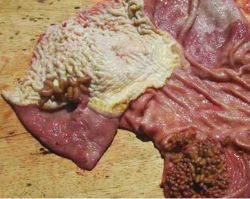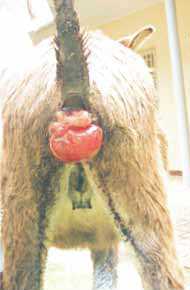Difference between revisions of "Bots - Donkey"
| Line 8: | Line 8: | ||
There are different opinions on the importance of bots in equids and some consider them to be non-pathogenic. | There are different opinions on the importance of bots in equids and some consider them to be non-pathogenic. | ||
| − | For the life-cycle click [[ | + | For the life-cycle click [[Gasterophilus spp.|here]] |
==Diagnosis== | ==Diagnosis== | ||
Revision as of 21:05, 30 March 2010
Stomach bots - Gasterophilus spp.
Introduction


Bots, the larvae of flies, have adult stages that occur externally which could classify them as ectoparasites, and also larvae that live internally that could put them in the endoparasites category.
There are different opinions on the importance of bots in equids and some consider them to be non-pathogenic.
For the life-cycle click here
Diagnosis
Diagnosis is difficult before bots appear in faeces, though fly eggs on hair may indicate that infestation is likely.
Clinical signs
G. nasalis larvae may be closely packed together, blocking the pyloric opening. The prevalence of rectal prolapses from the severe irritation of the larvae attached to the rectal mucosa is quite high and is a problem seen with donkeys in Ethiopia. There is evidence that stomach bots can cause mechanical blockage of the stomach, colic, abscess formation, ulcers and rupture of the stomach wall causing peritonitis in horses (Waddell, 1972).
Treatment and control
- Remove eggs from leg area with a damp cloth or a bot knife
- Treat with a single dose of ivermectin or moxidectin after the end of the fly season when the decrease in
temperature has killed the remaining adult flies
- Ivermectin has greater efficacy against bots, but this has to be weighed against moxidectin which claims greater efficacy against encysted cyathostomes which are often more problematic at the time of year when treatment against bots would be given.
References
- Trawford, A. and Getachew, M. (2008) Parasites In Svendsen, E.D., Duncan, J. and Hadrill, D. (2008) The Professional Handbook of the Donkey, 4th edition, Whittet Books, Chapter 6
- Waddell, A.H. (1972). ‘The pathogenecity of Gastrophilus intestinalislarvae in the stomach of the horse’. Australian Veterinary Journal 48. pp 332-335.
|
|
This page was sponsored and content provided by THE DONKEY SANCTUARY |
|---|
Italic text